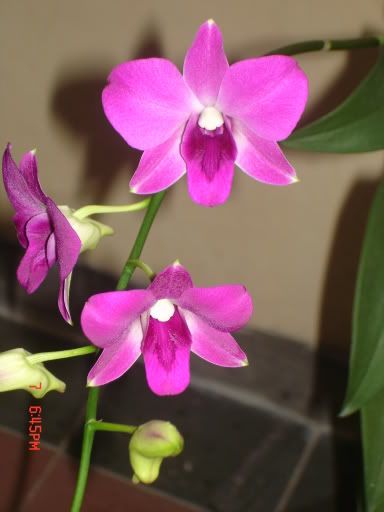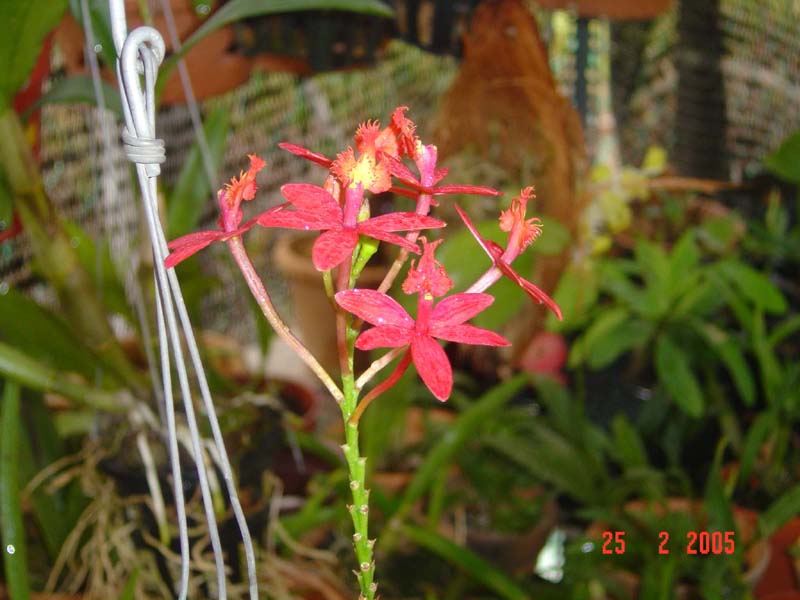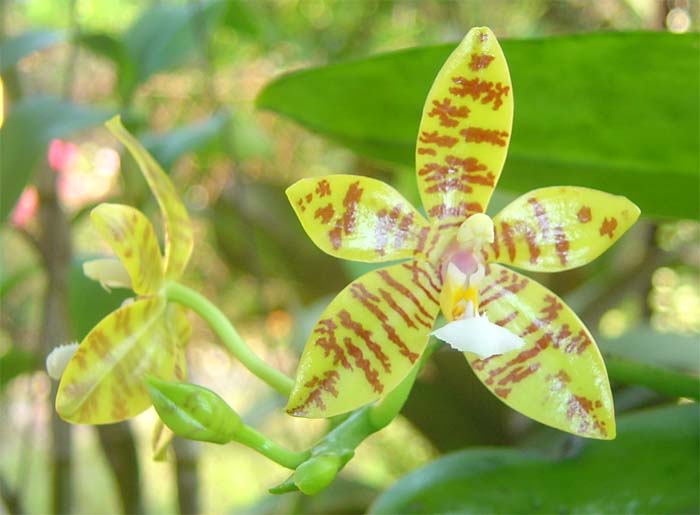|
|
cinta beralih arah... now kak hannah mula tanam orkid...

this one.. mekar lebih 2 bulan... lebih senang jaga and tahan lama...
ada 2 pokok.. satu bunga kecil.. satu bunga besar...
[ Last edited by noor_hannah at 3-7-2006 11:27 PM ] |
|
|
|
|
|
|
|
|
|
|
|
ini juga..

tgk ni.. terkenang pokok orkid yg arwah mak kak hannah tanam dulu merimbun bunga dia.. |
|
|
|
|
|
|
|
|
|
|
|
ini lagi

[ Last edited by noor_hannah at 14-5-2006 11:46 PM ] |
|
|
|
|
|
|
|
|
|
|
|
moknik pls welcome.. sapa2 lah yg suka orchids...
kat tmn orkid - dulu2 kak hannah pergi dorang ada jual mcm2 jenis orkid... few months back pegi.. closed sebab baik pulih.. tak tau dah bukak belum..
ingat nak pi jenguk sanalah.. kot2 ada banuyak species.. |
|
|
|
|
|
|
|
|
|
|
|
kak hannah sedang mencari yang ni

SPIDER ORCHID - Arachnis Maggie Oei 'Red Ribbon' |
|
|
|
|
|
|
|
|
|
|
|
Pests and Diseases
Orchids are not attacked by many pest, although even the best cultivated plants will be liable to damage from time to time. Prevention is better than cure, and therefore a regular monthly spraying with a systemic insecticide should keep most plants clean. Against this must be weighed the undersirability of spreading potentially harmful chemicals into the atmosphere. Whenever chemicals are used to kill insect pests, remember that most chemicals cannot differentiate between the insects and you - so it is most important to follow the manufacturers |
|
|
|
|
|
|
|
|
|
|
|
Aphids
Similar treatment of the red spider mite should also control the common aphids. Although Lindane and liquid derris will be equally effective and will help to avoid resistence to any one particular chemical building up in these pests. Although many forms of greenfly may appear, the orchid aphid is the most commonly found. The pale green aphids are particularly fond of tender young growths and flower spikes, the developing flower bud being especially attractive. Where these buds are attacked, the flower - if it opens at all- will be mottled and distorted.
Brown Spot
This disease, caused by the bacterium Pseudomonas cattleyae, occurs particularly in phalaenopsis and paphiopedilums. An early sign of infection is a soft watery area on the surface of the leaf, which, if left alone, will rapidly turn brown and spread. It is essential to cut out the infected area with a clean, sharp knife, after which the cut surface should be dusted with orthocide. Where a large number of plants are affected, they should be heavily sprayed with a solution of natriphene. Alternatively, all infected plants could be soaked in natriphene or Physan for approximately one hour. Many fungicides and bactericides are available, and those suitable for other greenhouse plants would be ideal for orchids.
False Spider Mite
In recent years, phalaenopsis have frequently been attacked by a false spider mite, which causes pitting on the upper surface of the leaves. If left unchecked, secondary fungal infection is probable, with the inevitable defoliation of the plant. The same treatment recommended for red spider mite should achieve effective control.
Mealy Bugs and Scale Insects
These two relatively common pests are more difficult to eradicate because of their protective outer covering. Both the mealy bug and the scale are sap-sucking insects, which feed by puncturing the suface of the leaf. They are clearly visible to the naked eye. Mealy bugs are covered with a waxy, whitish substance and frequently hide in the leaf axils of plants. Dendrobiums, especially nobile soft cane types, are particulary vulnerable to attack. Scale insects, as the name indicates, are protected by a dome-shaped hard shell, which is resistent to most chemical sprays. Systemic insecticide, which makes the plant toxic to sap-sucking pests, will control both these pests if applied two or three times at intervals of 10 to 14 days. Where only a small number of orchids is involved and infestations are minor, methylated spirit applied with a small paintbrush will clean up the plants.
Petal Blight
This disease is common on early autumn flowers of phalaenopsis and cattleyas. At first a few small circular spots may appear on any part of the flower. The spots are usually dark brown or black, and on close examination, have a slight pinkish margin. To treat the disease, first remove all infected flowers immediately, and then ensure that the night-time humidity is not too high. In temperate areas it will probably be necessary to supply a little artificial heat during autumn to prevent the problem from spreading.
Red Spider Mite
The most difficult pest to eradicate, and consequently the one most commonly seen is the red spider mite. These minute, sap-sucking pests are normally greenish yellow - rather than red - wingless and thrive in warm, dry conditions. They feed on the undersides of leaves.
Plants should be inspected regularly for red spide mite, which is just visible to the naked eye. Any leaf showing a slight whitish mottling on the underside is probably under attack. In severe infestations the leaves will turn yellow and a fine gossamer web can be seen on the underside. Although humid conditions will discourage red spider mite, a regular monthly spraying - using a systemic insecticide alternated with malathion - should be an effective control. Where active colonies have built up, three or four applications at 8 to 10 day intervals should eraticate each generation, as most chemical controls will not kill the eggs.
Slugs and Snails
The warm, humid conditions encourage slugs and snails. Metaldehyde is the traditional method of control, but liquid and pellet-form slug killers are also currently in use. The liquid has the advantage of treating the compost as well, thus poisoning one of the favorite hiding places. Bait in the form of an upturned potato or grapefruit skin, or even an orchid bloom, is also effective but relies on daily inspection and the disposal of any pests attracted to the bait.
Virus Diseases
Virus has become the dirty word of orchid growers during the past 20 years, and whilst the potential dangers of a virus disease should not be minimized, do not assume that every malformed flower or marked leaf is caused by a virus. If fact many plants that appear healthy may have some form of virus infection, and it is therefore essential that insect pests which spread viruses should be controlled. Many growers sterilize their cutting tools between use on each plant. Although this may seem fastidious, it is certainly advisable to isolate any plant about which you are suspicious.
Symptoms will vary according to the genus attacked and the virus, and plants that are not growing well will show more extreme signs of the disease at an earlier stage. With some genera, notably cattleyas, virus symptoms first become obvious in the flowers, which although they will open normally and appear healthy, will develop color breaks - irregular stripes or blotches of different colors - in either the petals or sepals after about a week. Isolate suspect plants so that subsequent flowers can be examined for any malformation, which, if present, will almost certainly confirm virus infection.
The only cure for infected plants, be they orchids or others, is to burn them. Hence the importance of thorough pest control and clean conditions within your collection.
Cymbidium Mosaic Virus
This virus is misnamed, as it will attack almost all orchids. Typical symptoms are chlorotic, or discoloured, areas on the leaf as a result of the breakdown of cells, these marks becoming darker and sunken as the disease advances. The marking often becomes regular, sometimes forming a diamond-shaped pattern on the leaf. On cattleyas and phalaenopsis virus infection often shows up initially as purplish markings, but these too become brown after a few weeks. |
|
|
|
|
|
|
|
|
|
|
|
jom jamu mata bagi segar skit..
C. aclandiae
 |
|
|
|
|
|
|
|
|
|
|
|
attee, wehh!!!
teman pun ada koleksi orchid... sejak 1993 tapi on off on off mode. kadang2 rajin tapi kadang sampai kering kontang orkid2 teman

epidendrim radicans red

Tiger phaleanopsis fasciata yellow/brown |
|
|
|
|
|
|
|
|
|
|
|
attee, wehh!!!

Dendrobium fimbriatum yellow |
|
|
|
|
|
|
|
|
|
|
|
Prof, x nampak pic lah  |
|
|
|
|
|
|
|
|
|
|
|
attee, wehh!!!
wehh.. mana dia gambo okid kamu?? attee.. tarak pun nampak apa2..hehehe.. |
|
|
|
|
|
|
|
|
|
|
|
Originally posted by spitfire007 at 15-5-2006 12:19 AM
attee, wehh!!!
teman pun ada koleksi orchid... sejak 1993 tapi on off on off mode. kadang2 rajin tapi kadang sampai kering kontang orkid2 teman
http://flanker007.tripod.com/orchids/orcred03_0 ...
wah.. ni mesti banyak expiriang ni.. meh lah share ngan kami spit... kak hannah baru nak kenal2 okid ni.. |
|
|
|
|
|
|
|
|
|
|
|
Reply #1 noor_hannah's post
attee, wehh!!
nak kata byk experience tu mmg bayk tapi hampir semuanya kantoi... mangkor kata org perak. orkid teman tak byk yg teman biak sendiri... dulu ada buat tapi dah tak sempat, sebok bebenor. yg ada ni pun tinggalan2 zaman dulu atau teman baru beli dari expo2. itu pun byk yg mati dek byk sebb antaranya yg mike lampirkan kat atas tadi. siput khinzir sini pun ganaz2 belaka. berbelas2 pasu dema belasah baru teman sedor, dah terlambat |
|
|
|
|
|
|
|
|
|
|
|
good info spit.. psl siput khinzir tu... hehehe... lepas ni kak hannah akan cuba peratikan siput khinzir tu..
tapi mana gambo tu.. wa tarak nampak lorr!!!
err.. kalau nice dia sebut sipu anje kot.. hihihi |
|
|
|
|
|
|
|
|
|
|
|
attee, wehh!!!
satu lagi....

Brassavola nodosa ... dia ni akan berbau wangi vanilla di waktu senja... naik seram |
|
|
|
|
|
|
|
|
|
|
|
|
My dear Prof, x nampak pun pic bunga kesayangan Prof tu mah, please help ler.....heheheheh |
|
|
|
|
|
|
|
|
|
|
|
Originally posted by yipun78 at 15-5-2006 12:44 AM
My dear Prof, x nampak pun pic bunga kesayangan Prof tu mah, please help ler.....heheheheh
atee, wehh!!!
bunga mana apa pulok ni???? :tq: :hmm: :hmm: :hmm:
:pmuka: |
|
|
|
|
|
|
|
|
|
|
|
|
Brasssavola nodosa mah, kenot c at all.... nite Prof |
|
|
|
|
|
|
|
|
|
| |
|